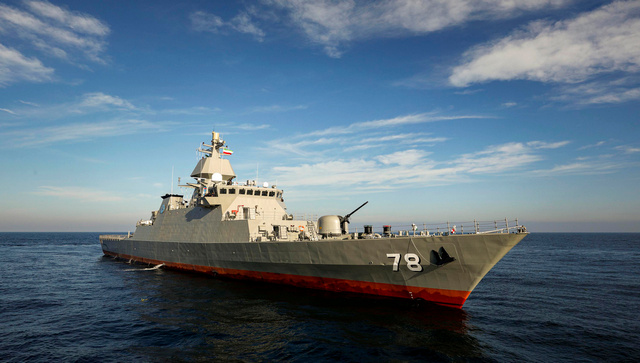Iran has added a powerful new weapon to its arsenal. A 1,400-tonne Deilaman destroyer, named after a town in northern Iran, can launch torpedoes while travelling at 30 knots (56 kilometres per hour). But what do we know about the Deilaman? Let’s take a closer look: What we know about the ship The vessel is 95 metres long and 11 metres wide. It can detect more than 100 targets, including vessels, drones, helicopters, submarines and aircraft, simultaneously. As per PressTV.Ir, Deilaman can for a long time, search, discover, identify, monitor and confront and, if necessary, repel any air, surface and subsurface threats.
It can also carry helicopters on its deck.
As per Mehrnews.com, the ship is part of the Mowj class destroyers which weigh around 1,500 tonnes. As per Jerusalem Post, the Mowj class destroyers, which are made indigenously, take their designs from Iran’s IRIS Jamaran destroyer which was launched in 2010. This is the fifth destroyer in the Mowj class. As per Tehran Times, the other ships in the class are the Dena, Sahand, Damavand and the Jamaran. While the information about the Deilaman remains scarce, it would be instructive to look at the other ships in the class. Jerusalem Post quoted Covert Shores website as writing about the Dena, “Despite being launched more recently, her superstructure is less modern than the preceding IRIS Sahand. That featured slightly canted sides to reduce the radar signature, and a new 30mm ‘Kamand’ AAA [anti-aircraft artillery], which is based on the Russian AK630 family. IRIS Dena has older weapons, such as the 40mm Bofors AA [anti-aircraft] gun.” (According to TS2 Space, AAAs have more firepower, but AA systems are highly maneuverable and can engage aircraft at shorter ranges.) “But the Dena does have a version of the Asr phased-array radar which may be a major step forward for the frigate program.” The unveiling of the ship occurred at the port of Bandar Anzali. During a ceremony marking the inauguration of Deilaman, Major General Mohammad Hossein Bagheri, chief of the Armed Forces General Staff called the Caspian a “sea of peace and friendship”. “Iran enjoys amicable all-out military relations with all the Caspian Sea littoral states, so the Navy has once again stressed on the message of friendship by building this destroyer, which is a great masterpiece in the history of the Navy,” Bagheri added. Bagheri added that Iran’s naval power there will serve “peace, security of commercial fleets, confronting terrorists and probable incidents in the future.” Iran’s Navy Chief Rear Admiral Shahram Irani was quoted as saying by the Eurasian Times that the ship is the most recent version of the Jamaran destroyer –with modern hardware. The Tehran Times quoted Irani as saying the ship is a powerful vessel that can act very well in the fields of “detection, interception, and rescue.” “Enemies always seek to infiltrate into the Islamic Republic through the sea but the navy of the army and the Islamic Revolution Guards Corps (IRGC) Navy in the Persian Gulf, the Strait of Hormuz and the Caspian Sea will not allow the enemies to do this,” Irani added as per PressTV.ir. Should Israel worry? Perhaps, say experts. “This is part of a tit-for-tat war between the US, UK, and Iran, and could draw other countries in,” Dimitris Maniatis, COO of private maritime security company Seagull Maritime, told Eurasian Times. “Iran’s Revolutionary Guard Corps Navy wants to influence the geopolitical scene and show they control the Straits of Hormuz.” This is the sixth warship Iran has commissioned in the Caspian Sea, the largest inland body of water in the world, shared by Russia, Azerbaijan, Kazakhstan, Turkmenistan, and Iran. Iran’s warships have made occasional visits to Russian and Azerbaijani naval bases in the sea in recent years, but Iran has also criticised Azerbaijan for its close military ties with Israel, which Iran sees as an archenemy. While Russia is the biggest naval power in the Caspian, Iran has tried to have a naval presence in the sea since the late 1960s, and has been adding to its strength since the 1990s. Iran also has three naval bases on the shores of the sea. With inputs from agencies
)